
Core Workouts For Running
Posted on 12 Mar, 2019

Strong legs are a must for runners, but to become a more resilient athlete a strong core is key. The problem is, core muscles don’t always get worked enough with just running, which is why core workouts and running should go hand-in-hand.
Improved Performance
The ability to maintain a stable torso and pelvis during running is important to minimize unwanted and inefficient movements. These “extra” movements or compensations will lead to wasted energy and compromised race performances or worse yet, overuse injuries. Especially with distance running, core muscles become very important in the latter stages of a race when fatigue sets in and form begins to fall apart. A strong core will help you hold proper running form longer, which naturally translates to improved performance.
A study from the Journal of Science and Medicine in Sport (Koblbauer et al., 2013) found that those who displayed better core endurance performance maintained better form when running in a fatigued state. Weakness or lack of sufficient coordination in core musculature can lead to less efficient movements, compensatory movement patterns, strain, overuse and injury.
Injury prevention
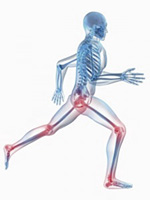 Full body, core and hip-focused exercises are a must if you want withstand the repetitive nature of running and run to your best potential.
Full body, core and hip-focused exercises are a must if you want withstand the repetitive nature of running and run to your best potential.
Research in the Journal of Clinical Biomechanics (Snyder et al., 2007) discovered that having good core strength reduces joint loading on the lower extremities when running. A number of studies have found that hip strengthening exercises play an important role in iliotibial band syndrome. [Clinical Biomechanics (Noehren et al., 2007) , Sports Medicine journal (van der Worp et al., 2012)]
Which are our core muscles?
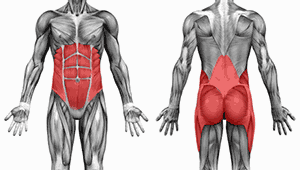 While experts may disagree on exactly which muscles comprise the "core" group, they almost all agree that improving muscular strength by developing the postural muscles will reduce your risk of injury and improve your performance.
While experts may disagree on exactly which muscles comprise the "core" group, they almost all agree that improving muscular strength by developing the postural muscles will reduce your risk of injury and improve your performance.
In our books, core muscles include the postural muscles, which includes the muscles of the back, stomach, hips and glutes. These muscles help us stand upright, transfer energy, and distribute the stress of bearing weight on two legs.
Where, when and how to do core exercises?
Most core workouts do not require weights or going to the gym. All you need is a little floor space!
 Many runners think they should do core exercises on their rest days, but it's best to do nothing on those days to really prioritize recovery. The best time for core exercises is actually after your running workouts. They serve as a good cooldown, and can actually reduce soreness in your legs.
Many runners think they should do core exercises on their rest days, but it's best to do nothing on those days to really prioritize recovery. The best time for core exercises is actually after your running workouts. They serve as a good cooldown, and can actually reduce soreness in your legs.
There is an abundance of core strengthening exercises out there, and the selection can be overwhelming. Here are some of the most effective ones to get you started, and they cover all the essential areas you should be concerned about. Start with a few repetitions and increase the number gradually.
The Basic Plank
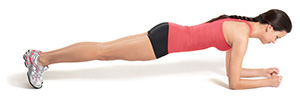
Lie on your stomach and prop your weight on your forearms and toes. Keep a straight line from your head to your heels, and hold this position for the entire exercise.
Your toes should be about hip distance apart with your elbows resting on the floor directly under your shoulders. Be sure your abs, glutes and lower back are engaged.
Simply hold it here for 30 seconds, and as you get stronger over time, work your way up to the point where you can hold the pose for a minute or more.
If you're up to the challenge, simultaneously lift the right leg and the left arm, hold for two to three seconds and switch.
For a demonstration of the basic plank, watch the video below.
The Side Plank
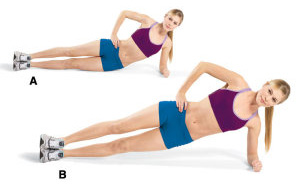
This is great for working the obliques (side abdominal muscles).
To perform this exercise, get on your side and lift your body so your weight is resting on one forearm and the side of one foot. There should be a straight diagonal line from your head to your feet.
Hold for 30 seconds, relax and repeat.Gradually increase repetitions and time.
A more advanced form of this exercise is to do 10 lateral leg raises while holding your pose.
For a demonstration of the side plank, watch the video below.
The Superman Pose

This move targets your entire back, an essential part of your core.
Lie on your stomach with your arms and legs extended so you look like Superman flying through the air. Lift your right arm with the left leg, then alternate sides.
The most advanced version is holding both arms and legs off the ground at one time.
For a demonstration of the superman exercise, watch the video below.
Supine Bridge
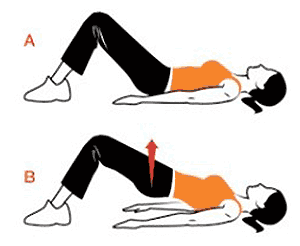
This is an exercise aimed at strengthening the glutes and helps lengthen the hip flexors. Performing this regularly will help reduce knee and lower back injuries.
To perform this move, lie on your back with your feet flat on the ground. Using your butt muscles, lift your hips so there is a straight line from your shoulders to your knees. Maintain this position for a few seconds, and then slowly lower your butt back down using the muscles in your abs and glutes.
Do not rest when you have lowered yourself. Instead, work on raising yourself back into a bridged position. Repeat this. A more advanced version of this workout is to extend one leg straight out, hold it for several seconds, and then put it back down on the ground.
For a demonstration of the supine bridge, watch the video below.
Photo Credits
Great Books For Strengthening Your Core

by Peggy Brill


by Eric Goodman

by Karl Knopf

 Are You Running Too Much?
Are You Running Too Much? Antioxidants - A Clear And Simple Explanation
Antioxidants - A Clear And Simple Explanation A Guide To Buying The Right Running Shoes
A Guide To Buying The Right Running Shoes










